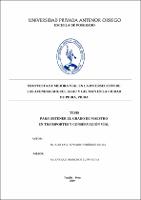| dc.contributor.advisor | Lujan Silva, Enrique Francisco | |
| dc.contributor.author | Henríquez Ulloa, Juan Paul Edward | |
| dc.creator | Henríquez Ulloa, Juan Paul Edward | |
| dc.date.accessioned | 2019-04-16T16:44:28Z | |
| dc.date.available | 2019-04-16T16:44:28Z | |
| dc.date.issued | 2019 | |
| dc.identifier.uri | https://hdl.handle.net/20.500.12759/4691 | |
| dc.description.abstract | La presente investigación se encuentra orientada al estudio de la Intersección de las
Avenidas Miguel Grau y Guillermo Gulman en la Cuidad de Piura, estas avenidas son muy
importantes en esta ciudad ya que en términos de su movilidad y accesibilidad se clasifican en
una avenida Colectora y Principal respectivamente, esto es debido a la gran cantidad de
vehículos que transitan y la variedad de funciones que se realizan en este espacio, a todo ello
se propone una mejor opción para reducir el caos vehicular.
Por lo antes mencionado, y para obtener una realidad situacional actual referente al tema de
congestionamiento, en el presente estudio se ha determinado las variables del tránsito tales
como el volumen de tráfico vehicular, tasas de flujo y velocidades, aplicando las metodologías
y procedimientos pertinentes; referente a la Capacidad Vial y Niveles de Servicio se ha
analizado mediante la metodología propuesta por el HCM para el caso de intersecciones
semaforizadas, además de la problemática en cuanto a tiempos semafóricos y geometría vial.
Así mismo, determinados y analizados estos y tomando en cuenta las propuestas de
mejoramiento que nos brinda MTC (Ministerio de Transportes y Comunicaciones) se ha
desarrollado la propuesta más óptima para la mejora vial de dichas avenidas.
Se concluye entonces, que durante los días de la semana la variación de volúmenes
vehiculares mixtos presenta similar tendencia de comportamiento en un intervalo de 7:00 am a
21:00 pm para cada acceso. Referente al acceso Este correspondiente a la Avenida Miguel
Grau, es el que presenta la demanda vehicular más desfavorable debido a que las moto taxis
representan la mayor parte de vehículos que transitan en todos los accesos, a esto se suma una
diversificación en las dimensiones vehiculares, geometría de los accesos, velocidades de
recorridos máximos y la pobre cultura vial, lo que en conjunto generan un régimen de
saturación vehicular en toda la zona de estudio. | es_PE |
| dc.description.abstract | The following research is oriented to the study of Miguel Grau and Guillermo Gulman
Avenues Intersection in Piura, Peru, these avenues are very important in this city, regarding
mobility and accessibility they are classified within a Colectora and Principal Avenue,
respectively, this is due to the large number of vehicles passing through and the variety of
functions performed in this space, which is why a better option is proposed, one that aims to
reduce traffic chaos.
As stated above, and in order to obtain a current situational reality regarding the issue of
traffic jam, in the following research, it has been determined the traffic variables such as the
vehicular traffic volume, flow and speeds rates, applying the relevant methodologies and
procedures; regarding Road Capacity and Service Levels, it has been analyzed using the
methodology proposed by the HCM in the case of signalized intersections, in addition the
problem in terms of traffic light and traffic geometry. Likewise, once determined and analyzed
these and taking into account the improvement proposals provided by MTC (Ministry of
Transport and Communications) it has developed the most optimal proposal for road
improvement of these avenues.
Therefore, it can be concluded that during weekdays the variation of mixed vehicle volumes
presents a similar trend behavior in an interval of 7:00 am to 9:00 pm, for each access.
Regarding the east access related to Miguel Grau Avenue, it is the one that presents the most
unfavorable vehicular demand because the motorcycle taxis represent the majority of vehicles
that transit in all the accesses, to this is added a diversification in the vehicular dimensions,
geometry of access, maximum travel speeds and poor road culture, which together generate a
vehicle saturation regime throughout the study area. | en_US |
| dc.description.uri | Tesis | es_PE |
| dc.format | application/pdf | es_PE |
| dc.language.iso | spa | es_PE |
| dc.publisher | Universidad Privada Antenor Orrego | es_PE |
| dc.relation.ispartofseries | T_MAEST.INGE_092 | |
| dc.rights | info:eu-repo/semantics/openAccess | es_PE |
| dc.rights.uri | https://creativecommons.org/licenses/by/4.0/ | es_PE |
| dc.source | Universidad Privada Antenor Orrego | es_PE |
| dc.source | Repositorio Institucional - UPAO | es_PE |
| dc.subject | Mejora | es_PE |
| dc.subject | Miguel Grau | es_PE |
| dc.title | Propuesta de mejora vial en la intersección de las avenidas Miguel Grau y Gulman en la ciudad de Piura, Piura | es_PE |
| dc.type | info:eu-repo/semantics/masterThesis | es_PE |
| thesis.degree.level | Maestría | es_PE |
| thesis.degree.grantor | Universidad Privada Antenor Orrego. Escuela de Postgrado | es_PE |
| thesis.degree.name | Maestro en Transportes y Conservación Vial | es_PE |
| thesis.degree.discipline | Maestría en Transportes y Conservación Vial | es_PE |
| dc.subject.ocde | https://purl.org/pe-repo/ocde/ford#2.01.05 | es_PE |
| renati.type | https://purl.org/pe-repo/renati/type#tesis | es_PE |
| renati.level | https://purl.org/pe-repo/renati/level#maestro | es_PE |
| dc.publisher.country | PE | es_PE |


